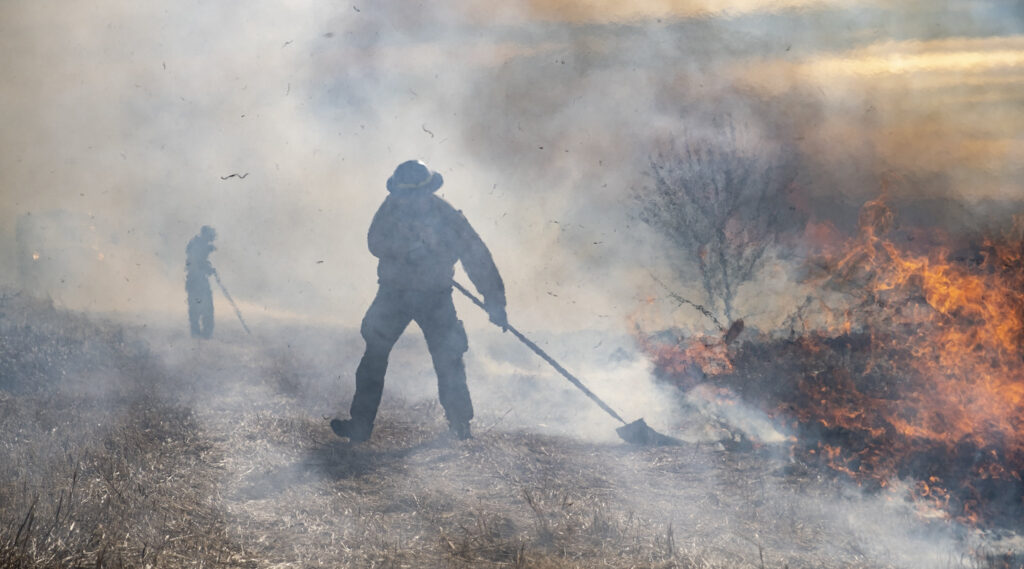This article was originally published in Homeland Security Today.
Scientists are warning that the coming months hold unprecedented wildfire risk for the western United States. Climate change is one factor driving that risk, but more than a century of suppressing fires on federal, state, and private lands has also contributed to conditions that drive larger, hotter, and more destructive wildfires. In recent years wildfires have created hundreds of thousands of internally displaced persons, degraded water systems, reversed carbon sequestration, increased carbon emissions, decreased air quality, and damaged ecosystems.
Reducing greenhouse gas emissions will help decrease fire risks over time. In the near term, however, streamlined, proactive forest governance and management are needed to avoid damages to property, the environment, and the loss of human life. Current plans and budgets for the U.S. Forest Service and other agencies recognize this reality. But with a backlog of more than 63 million federal acres that need treatment to reduce wildfire risk, engaging the wildfire threat requires more than improved planning and increased spending.
Partnering with states, counties, and private-sector actors with a stake in reducing wildlife risk can provide the investment to effectively engage with the threat. By streamlining environmental reviews, reducing litigation risks, and expanding existing authority to engage in public-private partnerships, the Forest Service and Congress can ensure that wildfires do not go from being a seasonal threat to an ever-present danger.
Climate Change and Fire Suppression Supercharge Fire Risk
Various climate-related effects, including changes in precipitation, increased aridity, and shifts in vegetation types, have made western forests more vulnerable to wildfire. These climate-driven conditions have emerged gradually and will continue over time, compounding the fire risk already present in the West due to more than a century of fire suppression. Decades of fire suppression have created an overabundance of fuel in western forests. When combined with the dry conditions that are now the norm, untreated woodlands are potential sources of immense destruction and social disruption.
According to the National Interagency Fire Center, more than 58,000 wildfires burned more than 10.1 million acres in 2020 – double the acreage burned in 2019 and more than 2 million acres above the 10-year average. These fires displaced more than half a million Americans and caused $13 billion in damages. The fires killed four firefighters and 29 civilians and led to a homeland deployment of the U.S. Army and National Guard.
The same year, California wildfires emitted 25 percent more carbon than the state’s burning of fossil fuels did. Meanwhile, in Oregon, wildfires burned half of the state’s largest forest carbon sequestration project. Smoke from the 2020 wildfires stretched as far east as Washington, D.C., eliminating nationwide improvements in air quality caused by decreased vehicular traffic and energy use during COVID-19 shutdowns.
The impacts of wildfire on municipal and agricultural water supplies are also proving to be immediate and long-lasting. California wildfires in 2017 and 2018 increased levels of the carcinogen benzene and other pollutants in water distribution systems. In 2020, the city of Fort Collins, Colo., faced a water shortage stemming from a 2012 fire that forced the city to cut off its intake from the fire-impacted Poudre River.
As bad as things have been, researchers now warn they may get worse. The San Jose State Fire Weather Research Laboratory recently announced unprecedented conditions in California that set the stage for fires in the state to begin earlier than in years past and burn with at least as much intensity and reach as they did in 2020. A report from the Colorado Division of Fire Prevention and Control warns the state’s residents to prepare for another season of large-scale destruction. The same holds across the West as the region’s drought intensifies and fuel loads in its forests remain high.
Getting Ahead of the Fire Threat
America’s security depends on both mitigating the effects of climate change by cutting carbon emissions and taking the steps necessary to make our lands, waters, and communities more resilient in the face of its ongoing influence. Our forests are one place where these two goals intersect. While the budgets of state and federal agencies reflect the growing awareness of the threat wildfire poses to American communities, the nation’s ability to get “left of boom” could be greatly improved via changes in federal forest policy that support partnerships between the Forest Service, states, counties, and private companies. It is essential to streamline agency processes, remove bureaucratic hurdles, and encourage a whole-of-society approach to engage the challenge and reduce near-term risk.
Policy Changes Can Provide Solutions
As our colleagues of ours note in a recent report, addressing the growing risk of wildlife will require more than larger agency budgets. It will require policymakers to empower land management agencies to engage with the threat effectively and make substantive changes to how we govern the nation’s forests.
First, environmental reviews under the National Environmental Policy Act should be streamlined for forest management projects intended to decrease fire risk. This should include increasing the number of acres that can qualify for a categorical exclusion from the act’s analysis requirements. This would allow more fuel to be removed from high-risk forests at a faster pace. To improve the ability of the United States to adapt to climate change, Congress should also consider creating national and homeland security exemptions from NEPA with narrow parameters that include forest management.
Second, Endangered Species Act consultations for wildfire risk reduction projects should be limited to projects that will have tangible impacts on listed species. Currently, a new endangered species’ listing or designation of critical habitat can upend a host of earlier management decisions fully consistent with the facts and law that existed when they were made. Such a designation can trigger additional, redundant analysis regardless of on-the-ground impacts to listed species.
Additionally, Congress should consider expanding the inter-agency nature of wildfire response to include the Department of Defense in wildfire prevention. This would allow for the use, when necessary, of the broad exemption to the ESA granted to the secretary of Defense. Doing so would ensure more timely decisions and allow for the appropriate balance between climate and other environmental concerns to be struck.
Third, litigation against forest management projects that would reduce wildfire risk should be required to be filed sooner than is currently required. This would decrease delays in treating forests to reduce wildfire risk and increase certainty for partners interested in helping forest management agencies decrease fuel loads. The Forest Service could also work with Congress to make litigation less disruptive by clarifying when a legal dispute ought to halt a project via injunction or by limiting how long preliminary injunctions can remain in place before a court ultimately decides a case.
Fourth, the Environmental Protection Agency should exclude prescribed burns from state emission calculations for the purpose of Clean Air Act compliance. Such controlled burns have been shown to be one of the most effective techniques to remove forest fuel loads, decreasing fire intensity by 67 percent and total burned area by more than 35 percent. While these burns do temporarily decrease local air quality, their impacts are less than those of a major conflagration.
Finally, land management agencies should improve their ability to work with partners across society to engage the wildfire threat. Currently, the Forest Service is prohibited from entering into contracts longer than 10 years to conduct projects that reduce wildfire risk. With the time horizon of fire risk expanding decades into the future, increasing the length of contracts would allow for better planning and more operational stability. To support these efforts, Congress and the Forest Service should work with the National Forest Foundation to establish a dedicated endowment fund that can be used for long-term wildfire risk reduction contracts and cost-sharing agreements.
Wildfire is a present and increasing risk to the health and safety of the American people. Engaging and diminishing the risk will require changes in how we govern and manage our forests. By removing bureaucratic barriers to forest management projects and increasing the Forest Service’s ability to work with partners, more forest acres can be treated to decrease wildfire risk. In the wake of a devastating fire season and the ever-growing danger, the time to act is now.





